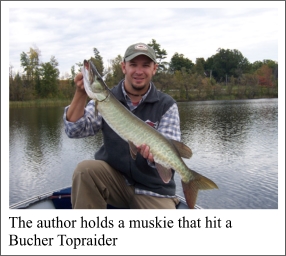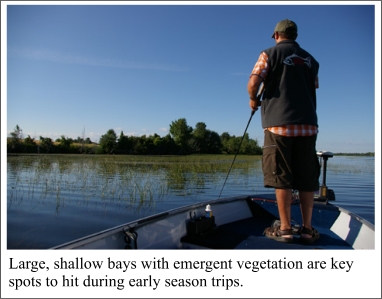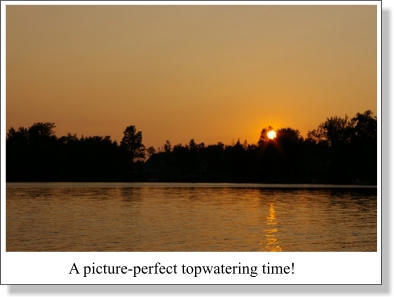|
"Muskies
on Top"
By Justin Hoffman
 In
the angling world the mighty muskie reigns supreme, conjuring up
images of razor-sharp teeth, truly immense size and extraordinary
power. In
the angling world the mighty muskie reigns supreme, conjuring up
images of razor-sharp teeth, truly immense size and extraordinary
power.
For the avid anglers who are part of the muskie fraternity, fishing
for these giants has become an obsessive trait that has literally
turned into a way of life.
Although muskies can be
caught with a variety of lures and techniques, nothing can quite
match the sheer excitement and thrill of utilizing a surface
presentation. Playing a well-orchestrated game of "cat-and-mouse"
makes for an interesting and productive time on the lake and, when
the water erupts in a shower of spray, there really is no better
feeling to be found in this sport we call angling.
Location is Key
When it comes to fishing topwater baits for muskies, one
specific location is always part of the equation and that is shallow
water, from the shoreline out to about 12-feet deep. Of course not
all shallow water is created equal. You can significantly increase
your chance of success by targeting specific areas within the skinny
zone.
Things to Look For
1. Vegetation-rich bays, points, shallow reefs and distinct
weedlines are great starting spots but, to up the odds even further,
concentrate your fishing on anything that appears different in
comparison to the surrounding area. Transitions from weeds to sand
or rock; people and boulder combinations; isolated cattails; logs,
stumps and fallen trees are all prime examples of something out of
the ordinary that will hold fish.
2. Weeds should be
green and healthy, with clumps, pockets and distinct edges present
in order to attract muskies. Muskies are ambush feeders so look for
them to hold on the inside or outside edge of the salad, waiting for
anything edible to swim by.
3. Pay particular
attention to areas that have nearby access to deeper water. Muskies
will wander back and forth between deep and shallow, using the
shallows as feeding areas and the deeper spots for resting.
Timing
Although topwater fishing for muskies can be effective during
both warm and cold-water periods, the technique is most effective
when water temperatures are above 58 degrees F. As water
temperatures climb, so does a muskies metabolism, making it more
likely to be aggressive and willing to bust a bait on the surface.
One of the best
indications that a midday surface bit might happen is when warm
temperatures and overcast skies are accompanied by southwesterly
winds, generally a sign of an approaching front. For whatever
reason, this combination really seems to stir up a muskies activity
level. In shallow, fertile lakes concentrate on large expansive bays
during this peak time, drifting with the wind and covering as much
water as possible. On deeper shield lakes, head to wind-blown points
or islands to cash in on this feeding spree.

Fishing during the
graveyard shift is another productive time to be out on the water.
Boat traffic will be non-existent, and the lake will truly become
yours - except for sharing it with the odd pesky mosquito! I prefer
to frequent many of my daytime haunts during the night, and have
found that both rock and weed locations will produce well. Sandy
beaches and swimming areas have also accounted for some BIG fish
over the years, so don't overlook these high-percentage areas when
out in the dark.
The Pro's
Perspective
Steve Wickens, who operates Strike Zone Muskie Charters out of
the Kawartha Lakes region, has seen first-hand the merits topwater
baits can bring to the muskie angler.
"My favourite topwater
baits would have to be the Suick, Cisco Kid Topper and the
Hellraiser Cherry Twist. Occassionally, I will also toss a Hi-Fin
Creeper or Arbogast Musky Jitterbug."
When it comes to
short-striking fish, Steve has a plan of attack that has proven
itself over the years.
"My favourite tactics I
employ on misses, depending on the size and aggressiveness of the
fish, are to cast back to the area using a spinnerbait, and bulge it
through the area at a fairly high rate of speed. If I suspect the
fish is very large, I will cast back with a spoon, and use a
combination of lifts and twitches to work it through the same area."
Richard Collin,
operator of Ottawa River Trophy Muskie Charters, is a firm believer
in the magic that topwater baits can provide.
"My favourite lure to
use would have to be the Bucher Topraider, as this bait works well
in all conditions and covers the water quickly and thoroughly."
Richard believes that
early morning periods and just before dark are the optimum times to
toss topwaters, and has had his most success during the early spring
and summer months.
Tips and Tricks
1. When fishing topwater baits for muskies, slow to medium
retrieve speeds generally give the best results, but it's always a
good idea to experiment. Sometimes muskie will be tuned in to a
specific speed or retrieve and getting it right can mean the
difference between catching fish or washing baits.
2. If a fish is spotted
following your bait, the best course of action is to continue your
retrieve at the same speed, gradually increasing the momentum as the
lure gets nearer to the boat. Once at boat side, a quick
ninety-degree change of direction with the lure, followed by a
figure-8, will often get that curious fish to lunge.
3. If you raise a fish
but it doesn't hit, try a few more casts then slip away and let the
area quiet down for an hour or so. When you return, try throwing a
different style of topwater bait. Oftentimes giving the fish a rest
before offering another type of bait will get it back in the mood to
strike.
4. Try suddenly
altering your bait's speed in mid-retrieve by sweeping your rod up
or to the side, dead sticking your bait, speeding up or slowing to a
crawl. Unexpected changes in the pace of the retrieve will often
trigger a lethargic fish to action.
5. When it comes to
setting the hook, many anglers stare defeat in the eyes due to the
fact that they strike far too early. Although the natural instinct
is to haul back on the rod at the first sign of a splash or a lunge,
having the patience to wait until the fish has the bait in its mouth
is the only way to ensure a solid hook set.
6. Calm conditions,
with little or no wind, call for surface baits that exhibit less
noise and speed. Walkers, creeper-style baits and surface running
jerk baits all fit the bill here, and are mainstays when the wind
runs out of steam.
|